#they have like. crocodilian snouts
Text
god one of the best character designs of all time is you make a funny creature and you have it go 👀



#I'm in love with the way tove jansson drew horses#they have like. crocodilian snouts#I was toying with adding marvin the m.artian bc that's a killer design too But#the pupils are not as a dilated that's the important detail#they have to look competely blown out and vacant#also I have to admit it. the designs of security breach are really fantastic. like those glam animatronics.. they are so cool ngl#if it weren't for the scott scuzz over the whole thing I'd prob check more of it out
26 notes
·
View notes
Text
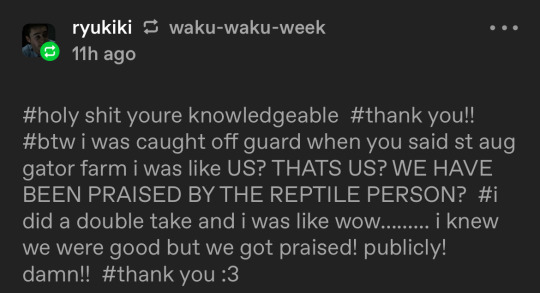
Aug ABSOLUTELY deserves the praise, @ryukikit. St. Augustine Alligator Farm is one of my favorite animal facilities, hands down. It's a pretty zoo, doable in an afternoon if you kinda like crocodilians, or an all day affair if you REALLY like crocodilians. Here are my favorite things about it and why I think it's worth supporting.
1. They keep animals in interesting social groups.

Crocodilians are heavily involved parents, but most places that breed them don't have the enclosure space to let the babies stay with the parents. St. Augustine does. One of my favorite groups was their crèche of slender-snouted crocodiles. They had the parents and then a yearling cohort and a new hatchling cohort. This aligns with how these guys live in the wild- the babies stick around longer! They have the space for it, and they are very in tune with the social needs of their animals.
Very, very few zoos can keep their baby crocs with the adults and still perform maintenance and animal health checks safely. This doesn't mean these facilities are bad- it just means that they have different management practices. And frankly, a lot of these species aren't frequently bred elsewhere. Your average zoo doesn't need a setup where you can have a multiyear crèche for slender-snouted crocodiles. Some species have better success when the young are pulled early, and some zoos are better set up to raise out any offspring separately or behind the scenes. Every facility's practices are different, and this just happens to work well at St. Augustine and be really enjoyable to see as a zoo patron.
Crocodilians are exceptional parents and very protective. It's a sign of incredible animal management practices and animals that feel very comfortable with staff that St. Augustine can do this with nearly every species they breed.
2. They understand the social needs of their animals.
Some crocodilians are social. Some are solitary. Some can live happily with a member of the opposite sex but get territorial around members of the same sex. St. Augustine pays incredible attention to their social groupings to ensure that they aren't just meeting the animals' physical health needs but their social needs as well. They do continuous scientific research about social structures in crocodilians, taking blood samples to test stress hormones and observing stress behaviors to see how group dynamics change.

For example, St. Augustine is home to one of the world's largest known living saltwater crocodiles, Maximo. And his comparatively tiny mate, Sydney. During the educational presentations with these two, they point out that even their monster of a croc needs his social group- he won't eat if she's not around and he is calmer during medical checks if he can see her. These animal share a deep and special pair bond, and they make sure to talk about how the social aspect of these animals' lives is integral to their care. It's a unique aspect of the way they talk about these animals, because he IS a spectacle and he IS a sensation, but they don't talk about him like he's a mindless killing machine- they talk about him like he's a big, complex predator with social needs like any other animal. Aug is the only facility I've been to where the emotional and social needs of crocodilians is part of the education they provide guests- and speaking of education...
3. Their demos and presentations are extremely good.
The presentations at St. Augustine are some of the best I've ever seen, and I've seen literally hundreds of animal talks on everything from aardvarks to zebras. But as you... can probably tell from my blog content, I've spent a lot of time learning about and working with reptiles. I really enjoyed all of their presentations because they are very scientific about things and avoid sensationalism. They really want you to be fascinated by these creatures and love them- but more than anything else, they want you to respect them.
Also, they do a really good job handling their ambassadors. I really enjoyed something as simple as watching an educator tell us about snakes. Throughout the whole presentation she made sure that most of the snake's body was looped in her hand. The snake was always supported and was very calm. She gave the snake plenty of head room so that it didn't feel constricted- it was just good handling all around.

But also, the presentations made it clear how much the park cares about the animals' well-being. When they do the feeding and training presentations, they make it very clear that the animals' participation is entirely voluntary. They do things differently for their 9-foot saltie and their 16-foot saltie, because the 16-footer is so large and heavy he actually struggles walking on land sometimes. They adapt their programs and his care to ensure that he's completely comfortable- and he didn't actually participate in the whole feeding when I was watching! At no point did they try to push him into anything uncomfortable; they offered, he didn't engage, and they moved on. It was a clear expression of his boundaries, and I really appreciated how much his caretakers respected that.
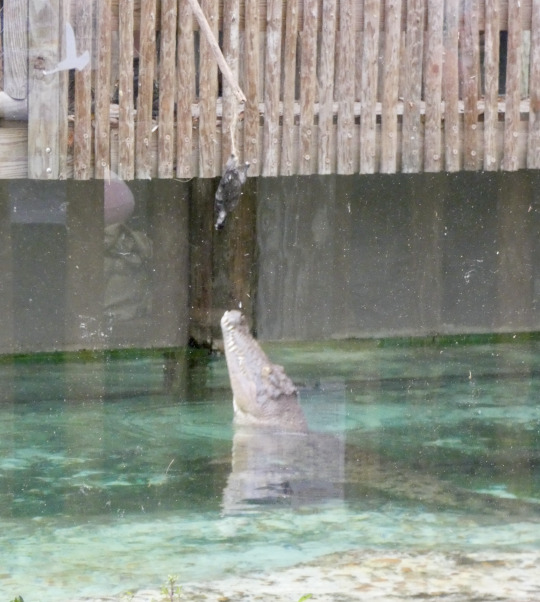
4. Ethical Interactions
I've been to... a lot of tourist locations in Florida that have animals you can hold. Almost always against my will! Many of them are pretty terrible, and you don't actually learn much, if anything. But I really found that to not be the case at St. Augustine. Every single animal presentation and interaction opportunity was accompanied by education about the animal's biology, habits, and- crucially- their conservation status.
When I held a baby alligator at St. Augustine, the proctors- there were two, one to ensure I was holding the gator correctly and the other to educate- were very informative about the role alligators play in their ecosystem and their conservation history. The animals were all properly banded, and one of the two proctors was there to ensure that none of the baby alligators were uncomfortable. As soon as they started getting squirmy or tense, they were removed, unbanded, and taken to an off-exhibit area to relax. And when the babies age out of petting size, they just go in the lagoon to live with others of their species. I saw one upset alligator the entire time I was there, and he was clearly upset that his escape attempt was foiled by a keeper during my nursery tour.
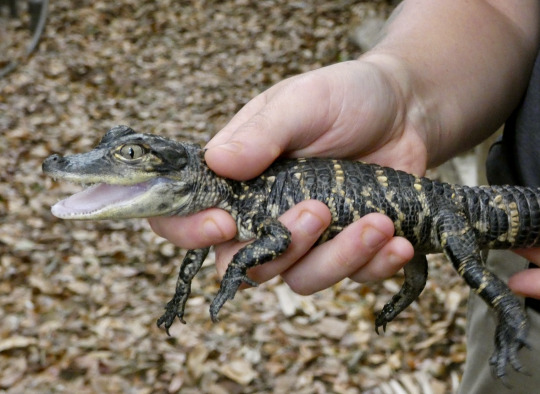
Even though he's restrained in this shot, you can see that his full body and tail are supported, and the grip, while firm, is gentle. He's distressed, but after I took this picture, she put him in his enclosure and he calmed down immediately.
Sometimes when you have petting attractions with baby animals, those animals... don't have a happy ending. (See: cub petting.) But St. Augustine's program is fine- the gators are all aged out of wanting to have mom around, there's no declawing/defanging, and they're handled with care. And it's worth it, because people love what they understand. St. Augustine was integral in raising public awareness about alligators back in the 60s when they were endangered, and now they're thriving- largely in part to programs like St. Augustine getting people to care.
And speaking of getting people to care, let's talk about their research.
5. Shared Research Results
St. Augustine is also home to more species of crocodilian than anywhere else in North America- all of them, usually. (They didn't have a Tomistoma when I visited- that may have changed.)
Because of this species diversity, it's an incredible research resource. Having every species means that you can do a lot of work comparing their behaviors, their growth patterns, and more. They've been a major research site for crocodilian biology since the 1970s. Today, they're one of the key sites for studying crocodilian play and social behaviors. They actually maintain a blog where they post copies of papers that were written using their animals, meaning that you can actually see the results of the research your admission helps fund. You can see that right here: https://www.alligatorfarm.com/conservation-research/research-blog/
All of this adds up to a zoo that provides a unique experience, tons of actual education, and transparency about what its research and conservation steps actually are. St. Augustine's come a long way since its opening in 1893, and they really do want you to leave with a new respect for the animals they care for. Ultimately, if you're a fan of reptiles, you can feel good about visiting the St. Augustine Alligator Farm- their care and keeping are top of the line, they do a ton of innovative conservation research and support for conservation organizations, and you can see this animal there:

(Gharial from the front. Nothing is wrong with her that's just what they look like from the front.)
6K notes
·
View notes
Text
Croc colours and patterns
Somewhat inspired by a recent post by Joschua Knüppe, I feel like it's a good thing to remind people just how diverse colours and patterns in modern crocodilians are. When I see people make art, it often seems to stick to grey or yellowish-brown tones, which is of course not incorrect. But theres a lot of, imo, underappreciated variety still. It's also worth noting beforehand that patterns are most striking in younger individuals and naturally become more muddy the older and larger an animal becomes. But as you will see, even some decently large and old animals may maintain a striking appearance.
Take this alligator for example. Gators tend to be on the darker side, dark greys to black, sometimes countershaded and sometimes pretty consistent. Some individuals, like this one photographed by Gar Luc, still retain clearly visible stripe patterns from when they are younger.
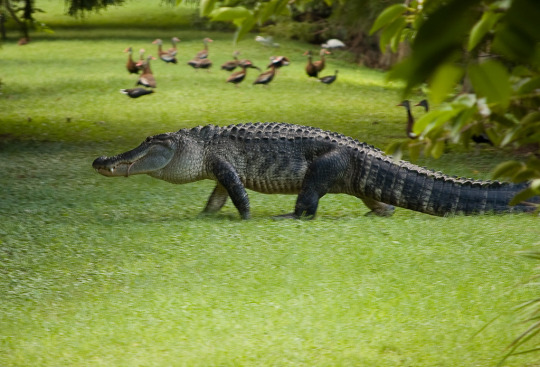
Or take one of my favourite species, the Cuban Crocodile, which can appear almost bright yellow with a dense pattern of leopard spots. Of course like with the gator you can find individuals that are much more drab, with washed out colours, but individuals with clearly defined patterns still exist.

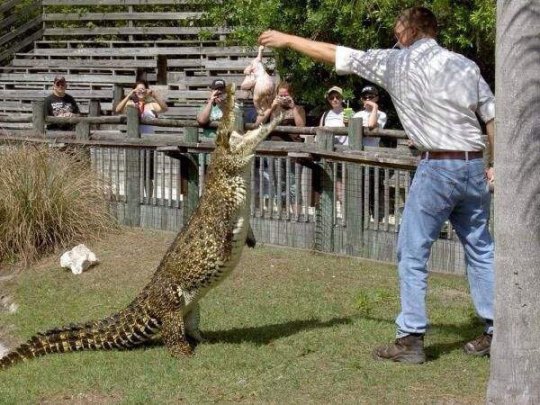
Then there's gharials of course. They can range quite a bit in colouration. They can be brown, especially younger ones and females and I've seen males range in colour from a drab grey to almost a light blue or even something that could be described as metalic black.
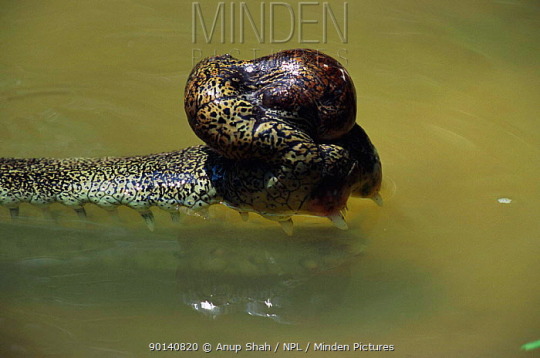


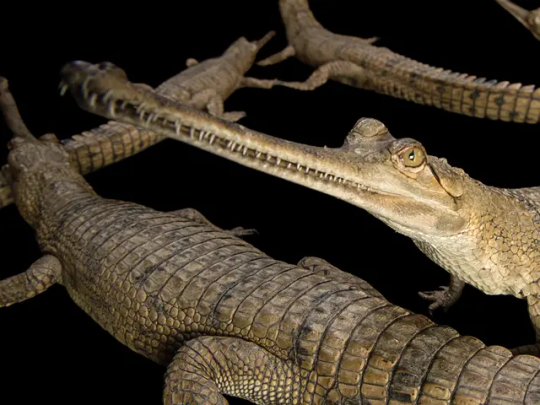
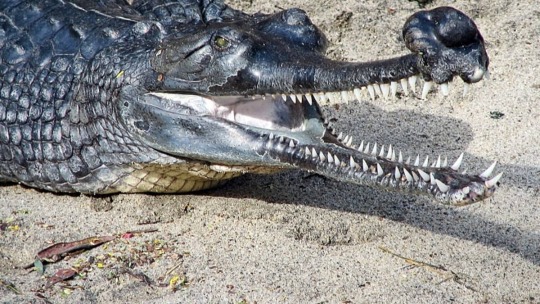
Black Caimans are also pretty interesting in my opinion and pretty easy to tell apart from other species once you pay attention to their colour. They are primarily a deep dark black of course, but what sets them apart from spectacled and other caimans is that very fine pattern of thin white stripes across the flanks that creates this beautiful contrast. They can also have patches of brown like the one on the right.


Orinocos also vary a great deal. Tho I know less about them than I wish I did, I know that individuals can range from drab brownish greys to yellow to somewhat earthy browns that almost range into reds.
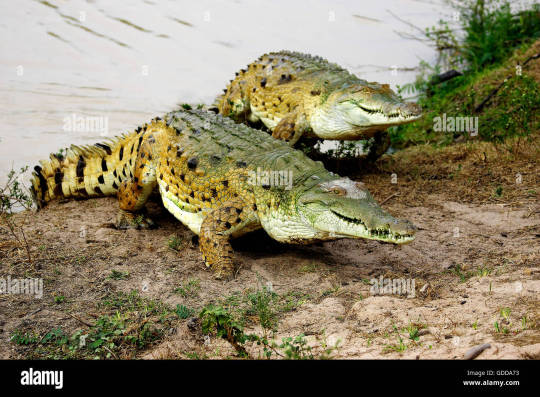
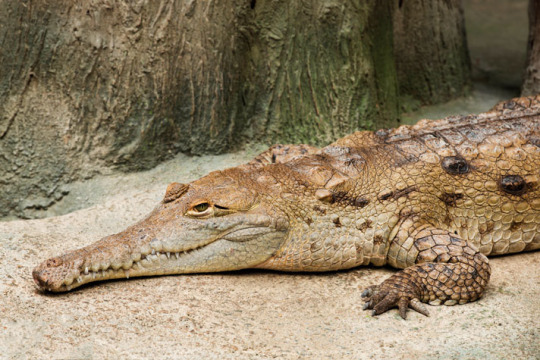
The next ones a bit of an outlier. There are specific cave dwelling dwarf crocodile populations in western Africa with striking orange colouration. Tho this one is not exactly natural pigmentation to my knowledge and instead the result of the chemicals present in the water they inhabit, brought there by bat guano. Still very pretty animals.
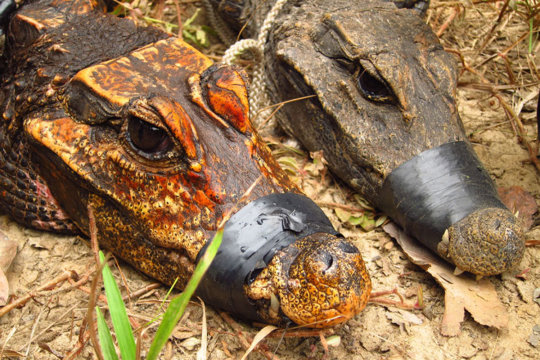
And then there's Paleosuchus, the dwarf caiman which contains two species. Again highly varied. The first image, which I believe is a Schneider's dwarf caiman, shows a very earthy brown. The others, which unless I'm mistaken are Cuvier's dwarf caimans, show colours ranging from dark with a rusty head, black to this still beautifully patterned individual. Of course these variations are also subject to change with age.



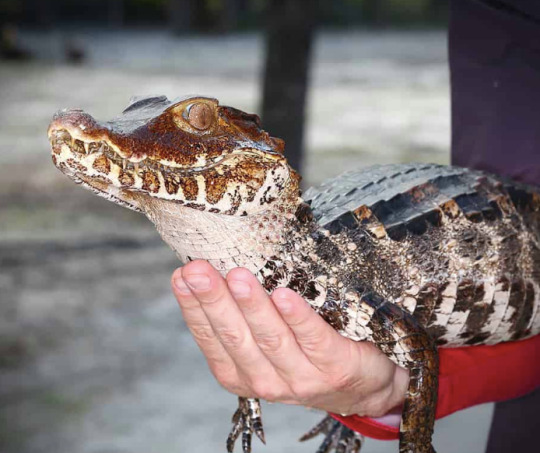
While salties aren't exactly known to be the most vibrant, I'd be remissed if I didn't mention this specific one. It's kept in a zoo in Germany and has this almost bizarre colour combination of creamy white underbelly and chocolate brown top which I've never seen in another saltwater crocodile. Photos by my friends Markus Bühler from the Bestiarium blog and René Dederich

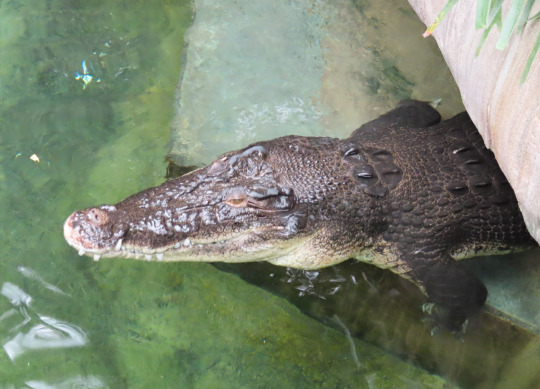
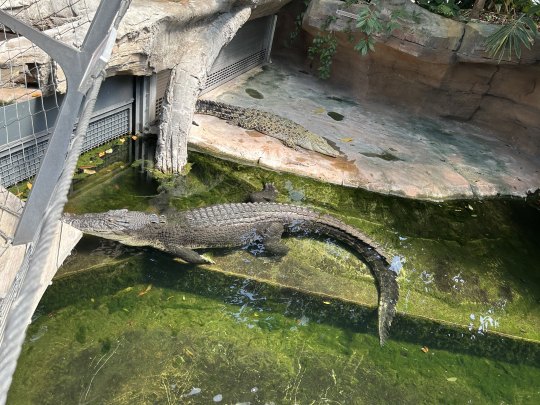
Spectacled, Broad-snouted and Yacare caimans I'll give a quick shout out. I think most people are familiar enough with how they look like and while their colours aren't anything special, I still think one should appreciate their patterns of spots and stripes and facial markings.

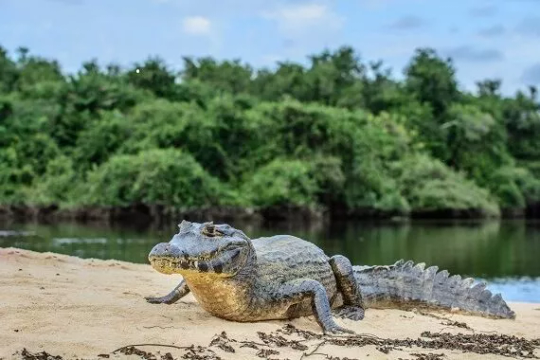


The last one I wanna highlight is the false gharial, Tomistoma, another one of my favourites. Part of the reason why being its at times beautiful reddish-brown colours.
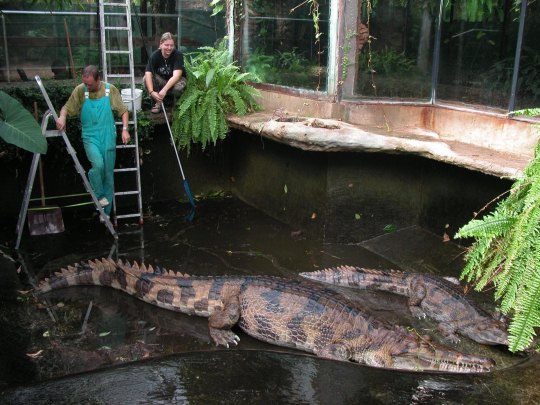
#crocodiles#crocs#gharial#gator#alligator#crocodilian#herpetology#reference#colours#inspiration#paleoart inspiration
2K notes
·
View notes
Text
Spectember/Spectober 2023 #08: Various Filter-Feeders
Admantus asked for a "freshwater baleen whale":
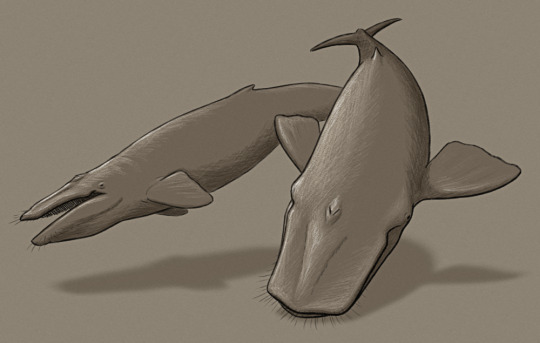
Rostrorutellum admantusi is descended from small cetotheres that became isolated in a large inland body of water (similar to the modern Caspian Sea), eventually becoming landlocked and gradually reducing in salinity towards fully freshwater.
Highly dwarfed in size, just 2-3m long (~6'6"-9'10"), they're slow swimmers with broad duck-like snouts that are used to scoop up mouthfuls of sediment and strain out their invertebrate prey in a similar feeding style to gray whales.
Due to the murkiness of the water, and the lack of large predators in their environment, they have poor eyesight and instead use sensory bristles and electroreceptors around their snouts to navigate and detect prey.
———
And an anonymous submission requested a "whale-like filter-feeding marine crocodile":

Sestrosuchus aigialus is a 6m long (~20') crocodilian closely related to the modern American crocodile, living in warm shallow coastal waters.
It's adapted for an almost fully aquatic lifestyle convergently similar to the ancient thalattosuchians, swimming with undulations of its long tail and steering with flipper-like limbs. But unlike other crocs it's specialized for filter-feeding, with numerous delicate needle-like teeth in its jaws that interlock to sieve out small fish and planktonic invertebrates from the water.
———
A couple more suggestions also asked for "fully aquatic pinnipeds" and "future crabeater seal evolution":

Euphausiolethrus volucer is a fully aquatic descendant of the crabeater seal. About 5m long (~16'4"), it occupies the ecological niche of a small baleen whale in the krill-abundant Antarctic waters that lack most actual baleen whales.
Its jaws contain numerous finely-lobed teeth that are used to strain krill from the water, and it utilizes all four of its wing-like flippers to swim in an "underwater flight" motion similar to that of plesiosaurs.
Highly social, it tends to congregate in pods that cooperate to herd swarms of krill for easier feeding.
#spectember#spectober#spectember 2023#speculative evolution#whale#cetacean#seal#pinniped#mammal#crocodile#pseudosuchia#archosaur#art#science illustration
246 notes
·
View notes
Text
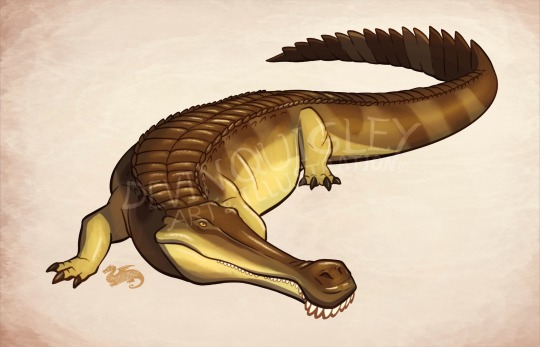
Paleovember 2023, Sarcosuchus!
Dating back to the Early Cretaceous, Sarcosuchus is a near-relative of modern crocodilians (not a true crocodilian itself) with species native to both Northern Africa and Brazil. The North African species, S. imperator, is estimated to measure up to 32 feet long! It's especially notable for the bulla, the large rounded portion of the end of the snout similar to the modern gharial. Unlike gharials, however, where the bulla is restricted to males, both sexes in Sarcosuchus seem to have a bulla, and while the gharial limits itself to eating fish, Sarcosuchus was more likely to be a generalist hunter of dinosaurs (though it wouldn't have been able to do the famous 'death roll' to rip it's prey apart).
#sarcosuchus#early cretaceous#pseudosuchia#crocodile#gharial#reptile#paleoart#paleontology#mesozoic#illustration#art#artwork#cartoon#digitalart#drawing#procreate#artist on tumblr
60 notes
·
View notes
Note
I've actually seen a few crocodile therians / alth, maybe like? One who is an artist on twt (I use their art as my banner!) And I always get so excited seeing more croc's cause I just think they're so cool so seeing one on the internet is super hype
What's it like being crocodile? Like what instincts do you feel and if you get shifts, what are they like? How did you come to realize youre a crocodile? Honestly just rant about being a big reptile crocodile in general, I'm so curious to know!
Only if you're comfortable ofc!
this is such a nice question to get :} it's even better since i need something to do atm, i'm currently stuck on an hour long bus ride -
being crocodilian is certainly interesting, and there are some urges that come with it. most often, it's the urge to eat raw meat (yes i know how common this urge is) however, this most often comes in the form of eating raw fish.
suprisingly, this isn't typically an issue for me, since i work at a grocery store that offers some pretty damn good sushi, but you know, it's pretty difficult to avoid the desire to bite into a slab of tuna every once in a while.
white this urge is common- it's not exclusive to my shifts. interestingly enough, my shifts have been coming around more and more often recently. crocodiles are social creatures, and i find myself most often shifting when around others (which is a little inconvenient, but not damaging). They usually take the form of phantom / astral limbs, most commonly tail, but i have had shifts with snouts and back ridges as well. however, i've also had issues with something i internally call "size dysphoria", you know, since being a 5'9 person isn't comparable to being a 15 ft long reptile. it's typically a little uncomfortable, but it doesn't last long and can be managed.
now, the question. how did i realize i was a crocodile? honestly, i don't really know. it's just something i came to one day. i've always been attatched to reptiles- particularly crocodiles. my friend, who is a wolf therian, introduced me to theriantropy at age 16. it was over time i began to realize that my connection to crocodiles ran deeper than i thought - i already had these cravings for raw fish, but honestly i just thought i liked sushi. it hit me just suddenly one day that i may be a crocodile therian- i asked my friend, told him my experiences, and sure enough, i was experiencing the same things as him. I also researched my species at this time, in all honesty, I'm still not sure, I'm either a nile or saltwater crocodile though.
that's really all i can think of at this time for my experiences, maybe i'll come up with some later and add on? but anyways, thanks for the question !! it's much appreciated, and feel free to ask anything else you'd like :}
#i absolutely love this question. tysm :}#<> open your jaw <>#otherkin#therian#alterhuman#nonhuman#therianthropy#reptilekin#crocodile therian#crocodilekin
20 notes
·
View notes
Note
Ok so I know you're not officially taking requests yet but this popped into my head and I just had to share it because I thought it was adorable and figured you might as well.
Its been pretty unanimously decided that Reptile is very inexperienced with pretty much anything human related, especially trying to flirt with someone. So say someone did catch his eye and he's trying his absolute hardest to flirt but of course they're human so they're not picking up on his signals. Feeling pretty dejected from that, who would probably be the best person to ask for advice? Bi-Han! I just picture that Reptile would probably be completely mystified about human mating customs and full of Why? questions and Bi-Han trying to keep a straight face explaining why a human wouldn't understand that him giving them a very nice rock means he's attracted to them. (Lizards like smooth flat rocks to lay on, so that's what my mind came up with.)
Yeeeeessssss Syzoth giving his s/o pretty rocks is so cute! I mentioned it in another post but crocodiles blow bubbles while courting their potential mates so I see Syzoth blowing bubbles in drinks around his s/o too! Another thing crocodiles do is rub their snouts together so Syzoth likes to rub noses with his s/o. I tend to follow a lot of crocodilian things for Syzoth because I happen to love crocodiles. I also know more about them than lizards, all I really know about lizards is they like sunny rocks and bugs lol I totally love the idea of Syzoth loving sunny rocks though
Poor Bi-Han having to explain everything to Syzoth lol it’s just like having to explain everything to his brothers all over again.
Syzoth: look at this pretty rock! Sunshine will love it!
Bi-Han: humans don’t care about rocks unless they’re diamonds.
Syzoth: what? Why?! It’s so smooth and flat! They’ll love it!
Bi-Han: *pinching the bridge or his nose* no, no they won’t, that’s not how humans work…
Syzoth: Well, how about I blow a lot of bubbles! Surely that will convey my interest!
Bi-Han: WTF are you five? Only children do that! *exasperated sigh*
Syzoth: no trust me, bubbles are a sure fire bet!
Bi-Han: *throws his arms up* fine Sy, do what you want!
54 notes
·
View notes
Text
Bigger, Scarier, More Teeth
Paleontology is, by its very nature, a very speculative science. For most of its history, we've only had fragmentary remains of ancient animals that sometimes have no easy modern day counterpart to compare with. Of course, the field is also good at self correcting these errors, which means our image of dinosaurs and other prehistoric creatures is constantly evolving. While admittedly we may never know with 100% accuracy what these animals were like, we can certainly narrow down and tweak our perception to come up with the closest possible image.
Then...there's instances where dinosaurs were deliberately modified. Not a case of misidentification mind you. Cases where the animal was physically altered in order to seem more impressive or threatening.

Case in point: the Giganotosaurus from Jurassic World Dominion. One of the most recent examples, the Giga was depicted with a row of spines running along its crocodilian esque back. Naturally, we have no evidence of these in actual specimens and was probably added to make the final big carnivore of the series look more threatening.
Admittedly I'm not gonna harp on too hard about this since there is a difference between a fictional portrayal and something that's supposed to be accurate and the Jurassic Park series isn't really known for its accuracy. This is honestly just a bench mark for what we're working with and a notable and recent example.
What's a bit more headscratching when said altering happens in more scientific portrayals of dinosaurs.
Take shrinkwrapping for example. For decades, shrinkwrapping was the standard fair in portraying dinosaurs. What it involved was basically showing visible bone structures underneath the skin of the animal.
The results were...

...basically skeletons with skin stretched over them.
The idea, as pointed out by Mark P. Witton in the link above, is not just to portray them as fast, agile, bird like animals, but also matching a popular but inaccurate depiction:
Secondly, images of prehistoric animals as heroically-built, powerful beings are preferred by many merchandisers and palaeoart fans, these interpretations most closely matching the erroneous but popular portrayal of prehistory as a savage struggle for survival, where only the most powerful animals survived.
Thing was, these depictions completely ignored the muscle and tissue underneath the skin which gives the animals more bulk in favor of portraying them as more intimidating. Which in retrospect didn't work since if a dinosaur looked shrink-wrapped in real life, it probably was starving, ill, or basically on the verge of death.
In contrast, there are some artists that go the complete opposite direction. As is the case with David Peters and his...unique look at pterosaurs.
David Peters, a once respected independent researcher and artist, once claimed that he was able to identify hidden features and anatomical structures in pterosaur remains that no-one else had been able to identify. These include elongated fleshy crests, spines, and extravagant feathers.

The results speak for themselves. It's almost astonishing that anybody would think that any animal could even fly with that amount of extra weight and protrusions.
Now while we can poke fun at paleoart all day, the thing is that altered dinosaurs or other prehistoric animals aren't just restricted to art alone. There have been cases where specimens themselves have been altered to look more impressive.
Such is the case with Irritator challengeri, a spinosaurid first discovered in Brazil, South America in 1996. While the original specimen is noted for having one of the most complete skulls of any spinosaurid anywhere, its name is referring to a much more...interesting background.
Irritator wasn't actually discovered by scientists. It was purchased from a fossil dealer which made its way to Germany’s Stuttgart State Museum of the Natural Sciences. In this case, material from the back of the skull had been removed, and placed on the tip of the snout, making the skull appear longer. Presumably this was to make the specimen more marketable. Paleontologist David Martill and his team had to painstakingly remove the altered bit of the snout and restore them to their original location. It was such a pain, they eventually named the species Irritator due to the difficulty of removing and reattaching the material without damaging the specimen.
But even the case of Irritator is nowhere near the levels of altering than the case of Archaeoraptor. AKA: the dinosaur that was completely made up.
Like with Irritator, the Archaeoraptor specimen was an altered fossil (also known as a chimera) sold on the fossil market. Though instead of a single specimen, it was several individuals put together to create a complete product that would sell for a much higher price. Smuggled out of China and sold in the US for $80,000 USD during 1999, it ended up in the hands of amateur dinosaur enthusiast Stephen Czerkas who wanted it to be the centerpiece of his museum in Blanding, Utah. Working with noted paleontologist Phil Currie and Chris Sloane of the National Geographic magazine, they determined that the specimen was the long sought-after missing link between dinosaurs and birds. A groundbreaking discovery like this would've revolutionized the field. So much so the magazine did a story on it and christened it Archaeoraptor even before a more formal study could be conducted.
The result: a complete disaster and embarrassment to both paleontology and National Geographic when it was revealed to be a hoax. Creationists had a field day, practically tearing the reveal apart and used it as evidence against paleontologists and their work. The zeal for the missing link resulted in an absolute blunder for science.
Ironically though, it's now believed that the two species used in the specimen belong to Yanornis (an early bird) and the famous Microraptor, both of which are stronger contenders for the title of "missing-link".
Here's a link to an excellent video by Dino Diego that goes into detail if you're interested: The Bizarre Archaeoraptor Hoax - YouTube
Needless to say, the field of paleontology is full of fabrications and falsehoods. And more often than not it's difficult to truly pick out what's real and what isn't. Which is a problem since it draws into question the validity of both research done by paleontologists, the work of paleoartists, and the very specimens themselves. Naturally it should come to no surprise that researchers need to be diligent in how dinosaurs and other prehistoric animals are portrayed and studied. Especially when sensation overcomes the truth many work so hard to find.
#dinosaur#dinosaurs#paleontology#paleoart#paleomedia#long post#giganotosaurus#shrinkwrapping#david peters#pterosaurs#irritator#archaeoraptor#fossil market#fossils#fossil chimera#feel free to check out the sources for more details
150 notes
·
View notes
Text
Massive dino from Brazil ate 'like a pelican,' controversial new study finds. Why is it causing an uproar?
The study reveals new information about the carnivorous dinosaur Irritator challengeri, but the research has been criticized because the fossils may have been illegally removed from Brazil.

A large predatory dinosaur related to Spinosaurus may have scooped up prey "like a pelican" by extending its lower jaw, European researchers propose in a new study. But the findings have upset some paleontologists who contest that the fossils were illegally taken from Brazil and should be returned to their country of origin.
The dinosaur at the center of the controversy is Irritator challengeri, a member of the family Spinosauridae — a group of bipedal, carnivorous dinosaurs with long, crocodilian-like snouts. The species, which grew to a max length of around 21 feet (6.5 meters), was first described in 1996 from 115 million-year-old fossils uncovered in the Araripe Basin of northeastern Brazil and later shipped to Germany, where they now reside in the Stuttgart Museum of Natural History in the state of Baden-Württemberg.
In the new study, which was published in the journal Palaeontologia Electronica, researchers digitally reconstructed the skull from the I. challengeri specimen housed in Stuttgart and discovered that the species' lower jaw could spread out to the sides, widening the animal's pharynx, the area behind the nose and mouth. This is similar to how a pelican widens its lower beak to scoop up small fish, suggesting that I. challengeri likely fed in the same way, the researchers wrote in a statement.
The new analysis also revealed that, due to its eye placement, I. challengeri would have naturally inclined its snout at a 45-degree angle and been capable of rapid-yet-weak bites. When combined, these features suggest that the snout would have been well suited to quickly scooping prey out of shallow water, the researchers wrote.
I. challengeri's journey from Brazil to Germany is a contentious one. The fossils were unearthed by nonscientific commercial diggers and were sold to the Stuttgart Museum before 1990, when Brazil began restricting scientific exports to other countries. As a result, the study's researchers believed that the fossils legally belonged to the Baden-Württemberg state.
However, an older Brazilian law dating to 1942 states that Brazilian fossils are federal property and cannot be sold, meaning that the fossil was technically stolen by the commercial diggers who exported it, Juan Carlos Cisneros, a paleontologist at the Federal University of Piauí in Brazil who was not involved in the new study, told Live Science in an email. "And buying something stolen does not make you its owner," he said.
Continue reading.
#brazil#germany#politics#science#paleontology#dinosaurs#brazilian politics#german politics#mod nise da silveira#image description in alt
62 notes
·
View notes
Note
*holds a mic up to your face* thot's on crocodilians?
Crocodilians have thots now?
They're AMAZING! Crocodilians are so so cool!
Crocodiles? Big. Beautiful. Stunning.
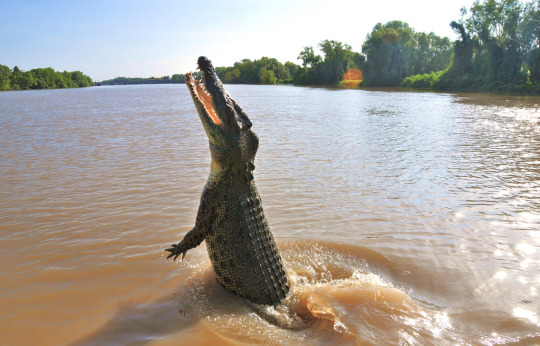
The athleticism! The grace!
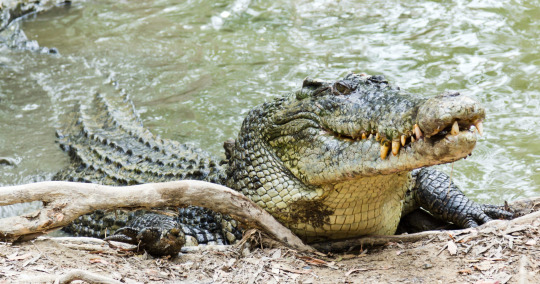
Alligators? Iconic. Literally no one is doing it like them. My favorite thing about them is how they have Cool Mode and Pancake Mode.
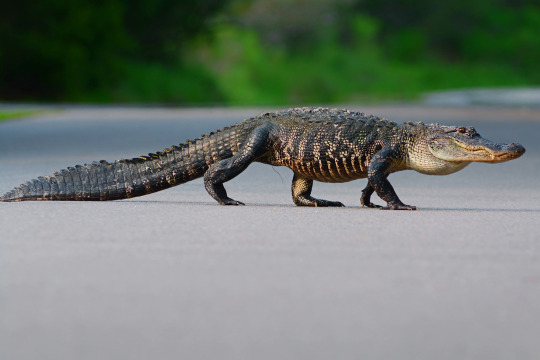
This alligator is going somewhere. He has places to be!
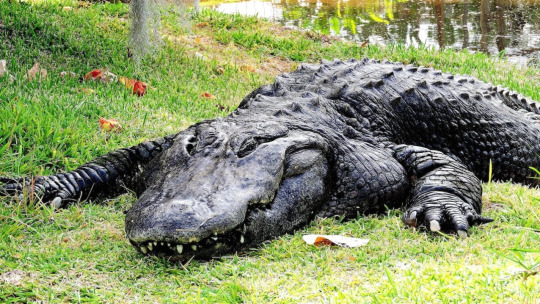
And this alligator is living life to the fullest!! He is RELAXING!
Caimans? Pointy. Little. Guys!
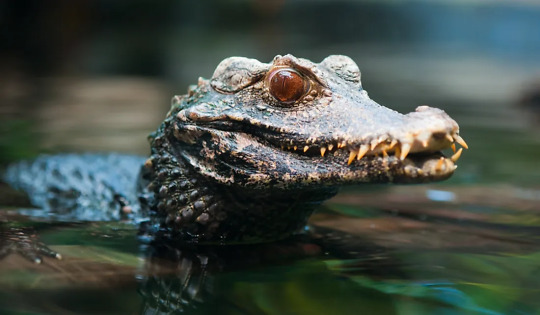
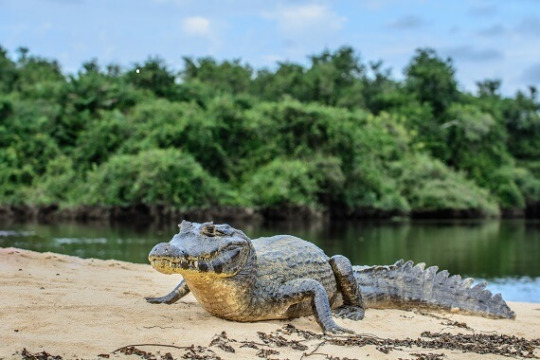
Gharials? Look at that snout! Like yes king you are so perfectly adapted to efficiently catch fish and thrive in your semiaquatic habitat!

Look at this good dad ferrying little gharials!
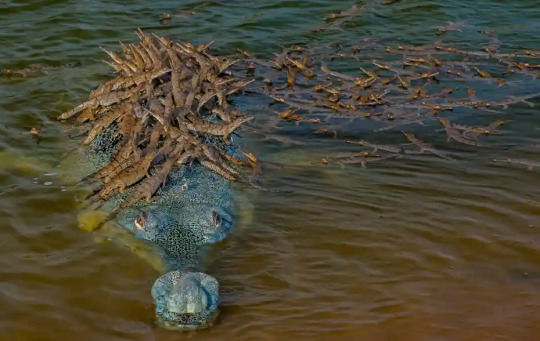
Tomistoma? Mysterious. These crocodilians keep us guessing and are actually generalists even though their snout shape looks like they should mostly eat fish! You go, you secretive little freshwater weirdos.
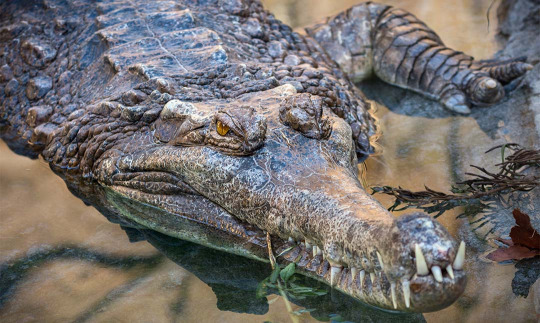
Crocodilians are so awesome. <3
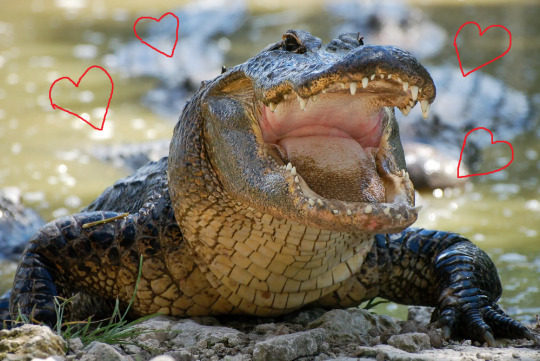
#not a rating#crocodilians#my coworker: what are you doing?#me: *closes tab where I'm doodling hearts around a picture of an alligator* work
533 notes
·
View notes
Text
Wings of Fire Dragon Guide, Part One: MudWings and SandWings

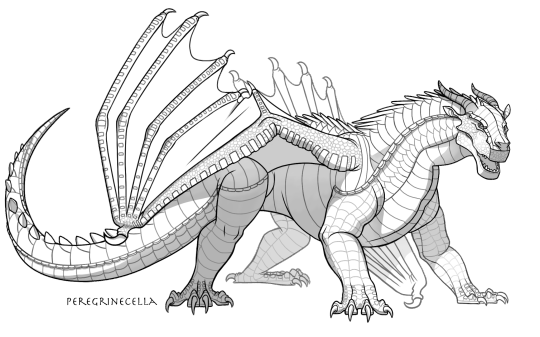


This is the MudWing, or mud dragon. They have brown, amber, and/or gold scales, can breathe fire if warm enough, and if born from a blood reg egg, are immune to burns/burns heal fast, have a flat nose on the top of their snout, and can hold their breath for up to an hour.. They live in groups of siblings mostly, and the oldest or first hatched us called the big wings, who will become their leader. MudWings live in the swampy Mud Kingdom, which has prey such as crocodilians, snakes, pigs, cows, chickens, etc. . They will eat almost anything, and are very loyal to their siblings. They can have names such as:
Bodies of Mud/Water: Swamp, Marsh, Bog...
Swamp Plants: Reed, Cattail, Sawgrass
Wetland animals: Copperhead, Egret, Crocodile...
Shades of brown: Taupe, Olive, Sepia...

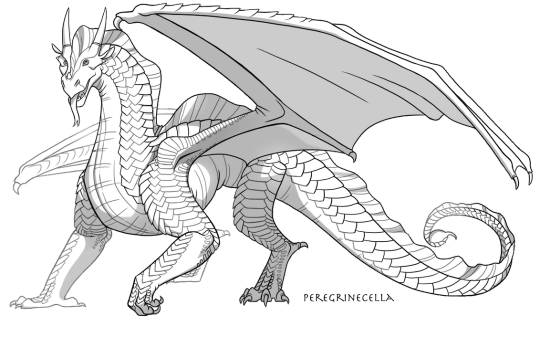


This is the SandWing, or sand dragon. They are pale gold, off-white, or tan, and live in the desert Kingdom of Sand. They can breathe fire and have a venomous barb, like a scorpion's, at the end of their tail, radiate heat from their scales,, and have forked black tongues. They eat lightly, preferring lizards or camel, and have eaten kebabs and camel milk. Have had animus dragons in the past (animus dragons are rare dragons born with magic that can do almost anything, but can't bring back the dead. Further limitations unknown). They can have names such as:
Desert animals: Scorpion, Vulture, Rattlesnake, Camel...
Desert winds: Sandstorm, Qibli, Sirocco...
Heat: Arid, Blister, Burn, Blaze, Char, Smolder...
Desert plants: Agave, Palm...
Sharp plants: Thorn, Prickle...
Sand formations: Dune...
#honeycomb thoughts#platonic yandere marvel#platonic yandere xmen#🐉wings of fire au#🥚tiny talons🐉 au#🥚tiny heir❄ au#🥚tiny sting🐝 au#🍯honey and venom🧪 au#🍷the heir of evil🐉 au
7 notes
·
View notes
Photo
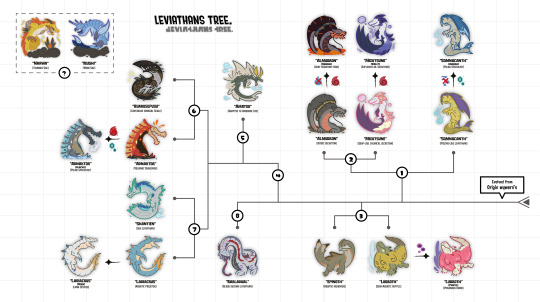

Leviathan evolutionary tree.
(One part of the larger MH evolutionary tree project)
Please leave a comment, i want your speculation on the subject and what type of monster you want to see next.
The description of the classification branch
A group of Semi-leviathan, Identified by a limb adapted for semi-aquatic life.
A group of Semi-leviathan with ability to secrete chemical compound out of their body, and posses an fur on their underside.
Identified by it short snout and reptile-like shape.
Identified by their crocodilian-like shape and limb more adapted for mainly aquatic life.
“Amatsu“ the leviathan that develope it body structure for entirely airborne life. It overall body still resemble an leviathans, but amatsu no longer posess a body function that allow it to be terrestrial.
This group of crocodilian leviathan has a hard, bony snout for diging or foraging.
This group of crocodilian leviathan have protruding spine around it back with various function.
“Barlagual” an strange leviathan that have an unique features, an limb more land based for something live in the midnight zone and an specialize tongue for consumtion of it prey blood.
The ??? group description
? (on the top left): “The deity serpent”, this species of wywern/dragon is really hard to identified due to it unique adaptation. It can be speculated to be an leviathan or an snake wywern, it have a unique adaptation of sexual dimorphism (Narwa is female, Ibushi is male) and a trait found in aquatic lifeform (fin like backleg and pharyngeal jaw).
119 notes
·
View notes
Text
Is It Ok For An Alligator To Have Tape On Their Mouth?
Alligators make pretty amazing animal ambassadors when handled safely and ethically. And it is actually pretty safe to take them out to interact with the zoo-going public (or general public in some settings), when done correctly. Many zoos and outreach organizations do an amazing job of this! Every state has different rules, but even if a state doesn't mandate that alligators be banded... well, if you're a responsible crocodilian handler, you'll band anyways. It's a huge public safety issue! Even an accidental graze against their front teeth can cause injury. See, the alligators that are used as handle-able ambassadors are pretty small, and their teeth are razor sharp. An adult gator has sharp teeth, too, as well as blunt teeth for crushing, and they also have the additional force of their jaw muscles.
Here's what it sounds like when an adult alligator pops his jaw. (Don't worry about the hissing/gaping; this is a trained and queued behavior. The stick towards the top of the inside of the mouth is triggering the bite reflex. Chester probably got lots of chicken and fish as he learned to do this.)
youtube
Skip ahead to 0:32 if you wanna skip the guest commentary.
What's more, biting is an important reflex for crocodilians. The lower jaws of crocodilians are some of the most innervated tissues in the animal kingdom; they are more sensitive than human fingertips! Even the slightest touch triggers their bite reflex, which likely is an adaptation that lets them detect changes in water pressure that signal a snack heading their way.
Here's a pretty good video about the biomechanics of crocodilian jaws:
youtube
So yeah. They need to not be able to bite for public safety. There's just too much risk involved with an unbanded alligator (or other crocodilian). Fortunately, it's easy to get a crocodilian to not bite- you just need to band its mouth!

(This fella is Frodo the dwarf caiman, but the principle is the same.)
This works because while crocodilians have an extremely strong bite force (claims range from 2,000 PSI to 5,000+ PSI, but I don't have time to get into that now but someday I will probably), but not particularly strong muscles to open their mouths. Selective pressure for quickly nabbing prey in murky water where there's not a lot of visibility lead to pterygoid and adductor muscles so big, they extend into the animal's neck. But those muscles only pull the jaw closed- they don't work to open it! That's why you see people holding an alligator's mouth closed with their hands.
Safe bands include:
Silicone tape- this is the best. It sticks to itself and not the gator's snout
Electrical tape
Medical tape
Rubber or elastic bands
There are other options, but these are the most popular- they're cheap, easily available, and safe. So if you see an alligator (or other crocodilian) out in public and it's got tape on its mouth, don't worry too much- it's safe for the gator (most of the time) and it's safe for you!
Here's a couple of safe tape options, modeled by a juvenile American alligator in pink electrical tape (I forget her name, these are from an outreach event a couple of years ago) and Pagasa, a juvenile Philippine crocodile wearing the white medical tape.
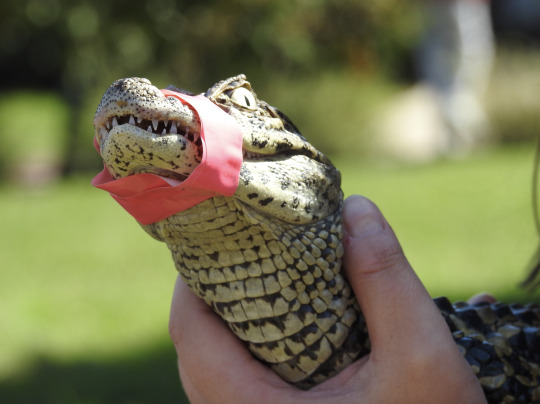

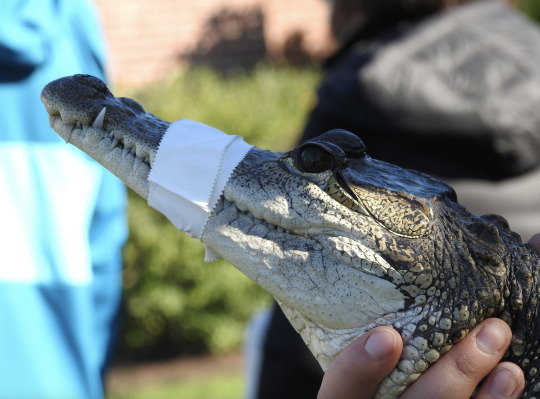
So when is tape not safe? When it's the wrong kind of tape. One of the worst offenders is duct tape.
When you're banding an alligator, you need to think about how sensitive their jaws are. A band that's too tight or too sticky can hurt them badly when it's removed- and you want that removal process to be fast, so that it doesn't stress them out too much.
What inspired this post was this picture I saw on Facebook:

That's so much duct tape! Now, this little guy is quite unhealthy; he's been loose in the Pittsburgh area all winter, and he's been struggling. What you see here is a very quick tape job done as he's getting ready for transport. The article didn't say who taped him, but given that he's in a dog crate and was found by bicyclists, I would wager that it was some harried animal control officer who was doing the best they could. And that's fine because this was truly an emergency situation. In an emergency situation, uncomfortable is always, always better than unsafe.
But if you see a tourist attraction and they've put duct tape on their alligator's mouth? That's a red flag! Banding an alligator in public is the safe, correct thing to do- you just want to make sure that it's done right.
If you want more information about alligator jaws, here's some interesting papers to read:
Erickson, Gregory et al. Insights into the Ecology and Evolutionary Success of Crocodilians Revealed through Bite-Force and Tooth-Pressure Experimentation. PLoS ONE 7(3): e31781.
Knight, Kathryn. Croc Jaws More Sensitive Than Human Fingertips. Journal of Experimental Biology (2012) 215.
Sellers et al. Ontogeny of bite force in a validated biomechanical model of the American alligator. Journal of Experimental Biology (2017), 220.
639 notes
·
View notes
Text
Varanosuchus: First Fossil Croc of 2024
We are two weeks into the year and we already had a bunch of big croc papers, so today I'll cover the first of the two new genera named so far.
Varanosuchus sakonnakhonensis (Monitor lizard crocodile from Sakon Nakhon) is a small atoposaurid neosuchian from the Early Cretaceous of Thailand, a country that has seen a virtual boom in croc papers this past year between the description of Alligator munensis and Antecrocodylus.
Varanosuchus was a small animal, maybe a meter in length if a little longer with a notably short and deep skull and long slender limbs revealing it to have been at least somewhat terrestrial. We actually have a decent amount of material of this guy. The holotype consists of a 3 dimensionally preserved skull as well as assorted postcranial remains (vertebrae, ribs, osteoderms and limbs), there is a second skull of whats likely to be a differently aged individual also showing a 3D skull and well the third ones just a skull table but 2/3 is still great.
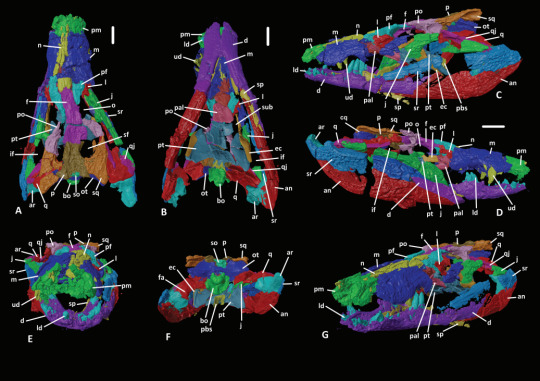

Now this guy was an atoposaurid, which is a group of crocodylomorphs that lived from the Jurassic to the end of the Cretaceous, their last members existing on the island of Hateg some 66 million years ago. Atopsaurids were generally small animals with short snouts and longish legs. Some examples of atoposaurids include Knoetschkesuchus from Germany, Aprosuchus from Romania and Alligatorellus from France and Germany, all three pictured below, art by @knuppitalism-with-ue
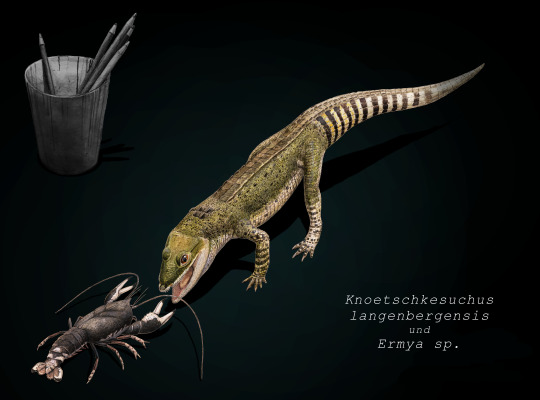
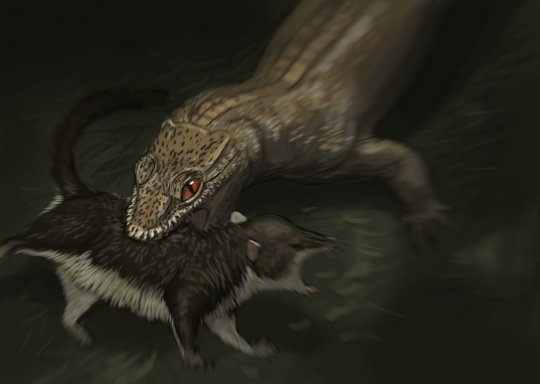
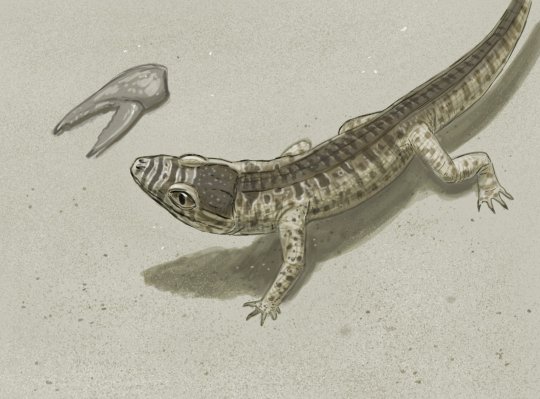
Now the matter of ecology for atoposaurids in general and Varanosuchus in particular is not clear. Altirostral skulls such as that of Varanosuchus are generally associated with terrestrial crocodylomorphs as best examplified by notosuchians. Their teeth and size both obviously speak against being shoreline ambush predators like modern crocs and their legs are straight and slender, suggesting they had an erect posture and not the more sprawling one seen in semi-aquatic forms. Though they could have still had some aquatic affinities. The authors for instance argue that the osteoderms, having plenty of pits, are more like those of an animal that spends time in the water and would thus use them in thermoregulation. So maybe they did enter water from time to time, somewhat like some modern lizards, tho I think its fairly certain that they spend a decent amount of time on land. The artwork below is the reconstruction from the paper itself.
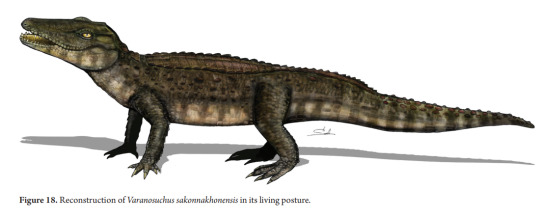
Another matter discussed in the paper is phylogeny, more precisely the relationship of Neosuchians and how Eusuchia is defined. On the first front, its worth noting that the paper recovered both atoposaurids and paralligatorids as monophyletic groups and had them be each others closest relatives, a notion that has been recovered before. More interesting perhaps is the fact that the next closest relatives to these two were hylaeochampsids and Bernissartia, which are typically recovered closer to modern crocs. Which in fact form a separate branch that is the sister group to all the afforementioned clades and taxa. And then you got goniopholids, dyrosaurs and pholidosaurs which are all more basal than the paralligatorid+atoposaurid+crocodilian group, which is back to the ordinary really. The second thing is the definition of Eusuchia. So for the longest time Eusuchia has been defined to include those Neosuchians that have choanae that are fully enclosed by the pterygoid bones (I know I know a bunch of anatomy stuff bear with me). So if the choanae was surrounded by the pterygoid, its an Eusuchian, if not, its more basal. Well, atoposaurids don't have that....BUT VARANOSUCHUS DOES. This, coupled with hylaeochampsids also having this feature and being recovered closer to atoposaurids than to Crocodilians basically suggests that the feature is not diagnostic for Eusuchia and instead appeared multiple times independently.
Moving away from anatomy and phylogeny and all that stuff, I think its very cool that croc research in Thailand has kinda picked up this last year. And fittingly enough some people have even worked on a short documentary covering the known diversity of pseudosuchians from Thailand, giving an overview over the named forms from the Jurassic to today, from titans like Chalawan to even these newest dwarf forms. While the narration is obviously in Thai, there are English subs and I highly recommend looking into it (even if I disagree with their depiction of Varanosuchus as arboreal, its perhaps overshooting the goal a little bit).
youtube
Finally here's the paper itself (tho paywalled)
New Cretaceous neosuchians (Crocodylomorpha) from Thailand bridge the evolutionary history of atoposaurids and paralligatorids | Zoological Journal of the Linnean Society | Oxford Academic (oup.com)
and the wikipedia page I've been working on
Varanosuchus - Wikipedia
I'll try to write up a post on the other new genus, Garzapelta, later this weekend so stay tuned for that.
#varanosuchus#atoposauridae#crocodylomorpha#neosuchia#thailand#cretaeous#pseudosuchia#croc#crocodile#land crocodile#prehistory#paleontology#palaeblr#long post#Youtube
192 notes
·
View notes
Text

Proterochampsids were a group of Triassic archosauriformes, closely related to the true archosaurs (crocodilians, pterosaurs, and dinosaurs/birds).
Known only from South America between about 242 and 205 million years ago, these reptiles' heads were wide at the back but very narrow along the snout, often with prominent bony bumps and ridges on their skulls, and they had less osteoderm armor on their bodies than other archosauriformes.
They've traditionally been interpreted as very crocodile-like and semi-aquatic, but their long slender limbs and presence in rather arid paleoenvironments suggest they may have been more terrestrial fast-running predators.
Tropidosuchus romeri here lived about 235 million years ago in what is now Argentina. It was one of the smaller proterochampsids, only about 50cm long (1'8"), with just a single row of osteoderms along its back, and had larger and lower-set eyes compared to its relatives.
CT scans of its braincase indicate it had a particularly good sense of smell, and it may have relied mainly on scent to locate prey.
———
NixIllustration.com | Tumblr | Twitter | Patreon
#science illustration#paleontology#paleoart#palaeoblr#tropidosuchus#proterochampsidae#proterochampsia#archosauriformes#archosauromorpha#reptile#art
460 notes
·
View notes
Text








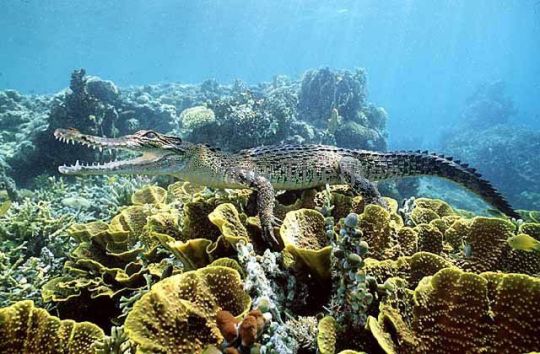
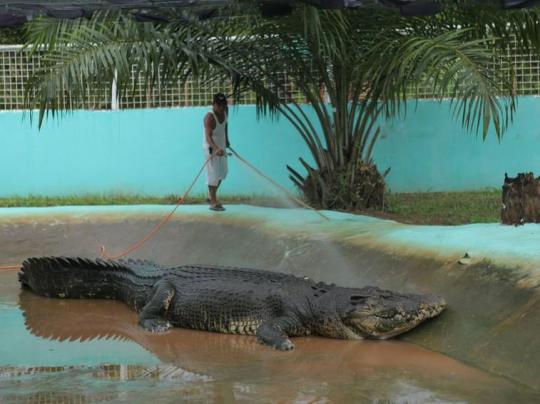
The saltwater crocodile (Crocodylus porosus) also known as the estuarine crocodile, Indo-Pacific crocodile, marine crocodile, sea crocodile, or saltie, is a large species of crocodilian which has a wide range being found throughout India, Southeast Asia, Australia, and Micronesia. Here they inhabit coastal lagoons, wetlands, deltas, estuaries, mangrove swamps, rivers, and freshwater lakes. These moderately social yet extremely aggressive crocodilians feed on a wide variety of prey including invertebrates, fish, amphibians, snakes, reptiles, birds, and various mammals from as small as bats to as large as gaur. Saltwater crocodiles exhibit a great degree of sexual dimphorism with males often reaching 4 to 5 times the size of females. They are also on average the largest extant crocodilian with the biggest males reaching 18 to 23ft (5.5 to 7m) in length and 2,000 to 3,300lbs (900 to 1,500kgs) in weight. In comparison female saltwater crocodiles get to around 8 to 14ft (2.5 to 4.3m) in length and 165 to 1,000lbs (75 to 455kg) in weight. Both sexes have a broader snout and body compared to other crocodile species with a pair of ridges that run from the eyes along to the center of the snout. There coloration is generally a tan to greenish grey in color; but there is variation in color among different populations with some appearing a yellowish tint and others almost black. Like the american crocodile, saltwater crocodiles sport salt glands on their heads that can secrete excess salt, allowing them to drink salt water. Saltwater crocodiles have the highest bite force of any animal recorded at 16,414 newtons (3,690 pounds-force). Breeding occurs during the wet season, during such time a male saltwater crocodile will approach a female in his territory - if she lets him get near, the two will court by rubbing their heads together before mating underwater. The pregnant female will carry her eggs with her for 1 to 2 months before building a nest on the edge of a tidal river or lagoon, laying the clutch inside. She will guard them fiercely for 80 to 98 days, at which point the young crocodiles will hatch and be cared for for the first 8 months of their lives. It's at this point they become large enough to become independent, fending for themselves now they are no longer vulnerable. Females reach sexual maturity at 12 years old, and males at 16. Under ideal conditions a saltwater crocodile may live upwards of 70 years.
#pleistocene#pleistocene pride#pliestocene pride#pliestocene#cenozoic#crocodile#saltwater crocodile#marine life#ocean#saltie#estuarine crocodile#indo pacific crocodile
15 notes
·
View notes